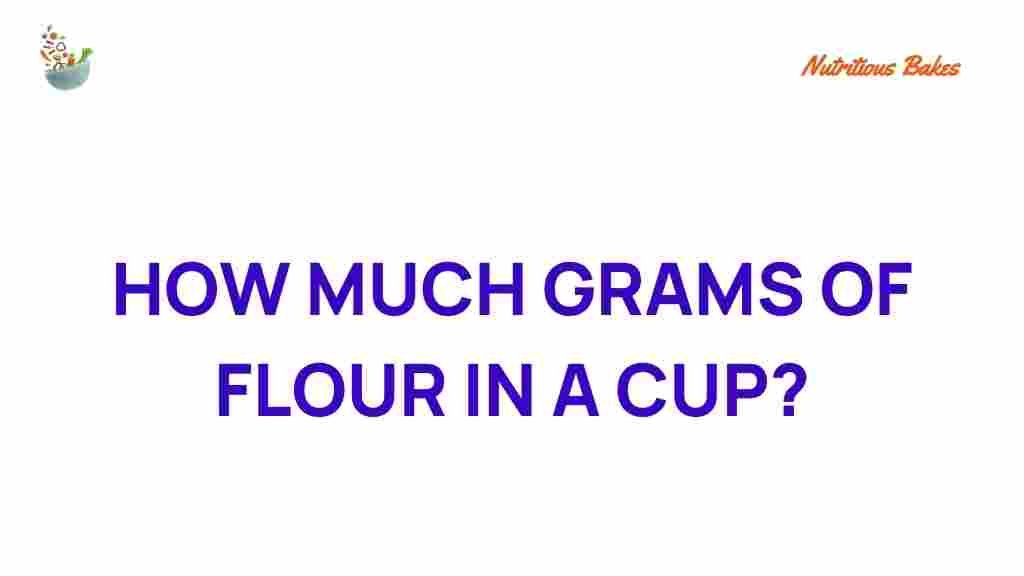Unlocking the Mystery: How Many Grams of Flour Are in a Cup? – A Flour Conversion Guide
When it comes to baking, precision is key. One of the most common questions home bakers ask is, “How many grams of flour are in a cup?” Understanding flour conversion is crucial for achieving recipe accuracy. In this article, we will delve into the details of measuring flour, explore the differences between various types of flour, and provide you with essential baking tips that will ensure your culinary creations turn out perfectly every time.
The Importance of Accurate Measurements in Baking
Baking is a science, and like any science, it requires precision. Unlike cooking, where you can often adjust ingredients on the fly, baking demands exact measurements to achieve the desired outcome. Here are some reasons why accurate measuring is essential:
- Recipe Accuracy: The right amount of flour can make or break your recipe. Too much or too little can lead to dense cakes or flat cookies.
- Culinary Precision: Accurate measurements ensure that the chemical reactions involved in baking occur as intended.
- Consistency: If you want to recreate a successful dish, precise measurements are vital for replicating results.
How Many Grams of Flour Are in a Cup?
So, how many grams of flour are in a cup? The answer depends on the type of flour you are using. Here’s a breakdown of common flour types and their equivalent weights:
- All-Purpose Flour: 1 cup = 120 grams
- Whole Wheat Flour: 1 cup = 130 grams
- Bread Flour: 1 cup = 130 grams
- Cake Flour: 1 cup = 110 grams
- Self-Rising Flour: 1 cup = 125 grams
These measurements are essential for anyone looking to ensure their baking is consistent and accurate. Remember to always check the type of flour specified in your recipe, as using the wrong type can significantly affect the outcome.
Understanding Flour Density and Measuring Flour
Flour density can vary based on how it is packed. Here are some tips for measuring flour accurately:
- Use a Scale: The most reliable method for measuring flour is to use a kitchen scale. This helps you achieve culinary precision by measuring flour in grams.
- Fluff It Up: Before measuring, fluff up the flour in its container to aerate it. This prevents packing, which can lead to excess flour in your measurement.
- Use the Spoon and Level Method: If you don’t have a scale, use a spoon to scoop flour into your measuring cup, then level it off with a straight edge (like a knife) for accuracy.
Step-by-Step Process for Measuring Flour
Here’s a detailed step-by-step process for measuring flour accurately:
- Gather Your Tools: You will need a kitchen scale or measuring cups, a spoon, and a leveling tool.
- Fluff the Flour: Use a whisk or spoon to fluff the flour in its container.
- Scoop the Flour: Use a spoon to add flour to your measuring cup without packing it down.
- Level It Off: Use a straight edge to level off the excess flour on top of the measuring cup.
- Weigh It (Optional): If you want to double-check, weigh the flour on a kitchen scale to ensure you’re using the correct amount.
Common Baking Mistakes and Troubleshooting Tips
Even with accurate measurements, mistakes can happen. Here are some common issues and how to troubleshoot them:
- Too Dense or Heavy Baked Goods: This often indicates too much flour. Ensure you are measuring correctly and not packing the flour into the cup.
- Dry or Crumbly Texture: If your baked goods are dry, you might not be using enough flour or you may have omitted a liquid ingredient.
- Flat Cookies: If cookies spread too much, it may be due to insufficient flour or incorrect oven temperature.
It’s essential to understand how ingredient conversion works. For instance, if you need to convert a recipe from cups to grams, using a conversion chart can be very helpful. You can also find helpful resources online, such as King Arthur Baking’s Ingredient Conversion Tool.
Additional Baking Tips for Recipe Accuracy
Here are some additional baking tips that can help you enhance your culinary skills:
- Read the Recipe Thoroughly: Before you start baking, read through the entire recipe to understand the steps and gather all your ingredients.
- Use Room Temperature Ingredients: Many recipes call for room temperature butter and eggs, which can affect how your baked goods rise and bake.
- Preheat Your Oven: Always preheat your oven to the specified temperature before placing your baked goods inside.
- Don’t Skip the Sifting: If a recipe calls for sifted flour, sift it before measuring to ensure light and fluffy results.
Conclusion
Understanding how many grams of flour are in a cup is essential for anyone who loves to bake. Accurate flour conversion and measuring flour correctly can significantly impact your recipe accuracy and overall baking success. Remember, baking is both an art and a science, and achieving culinary precision will elevate your creations to new heights.
Whether you’re a novice baker or a seasoned pro, using these baking tips and techniques will help you avoid common pitfalls and produce delicious results every time. So next time you’re in the kitchen, remember the importance of accurate measurements, and unlock the mystery of flour conversion for your baking endeavors!
For more tips and tricks on cooking measurements and ingredient conversion, check out our other articles or visit Baking Mad for more resources. Happy baking!
This article is in the category Tips and created by NutritiousBakes Team
